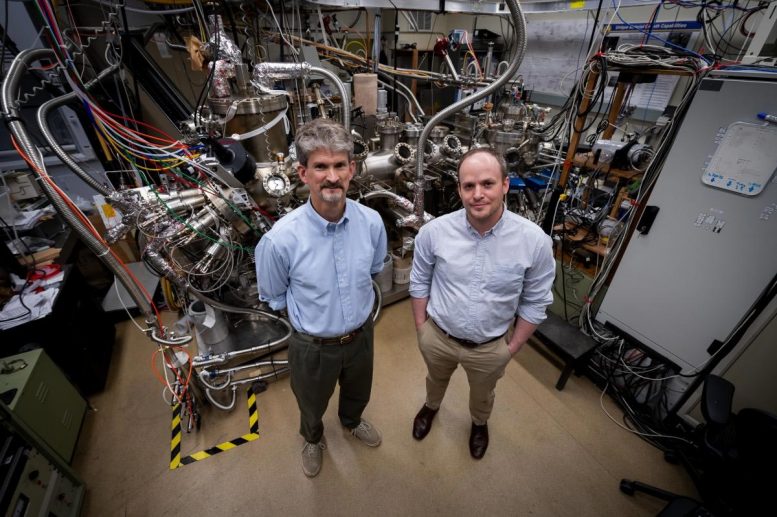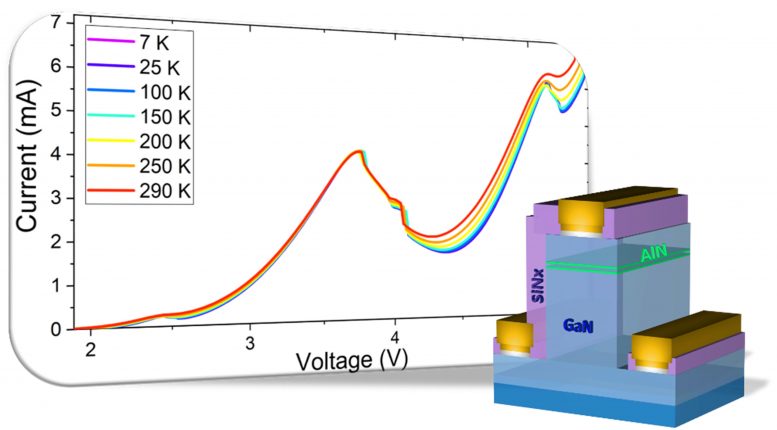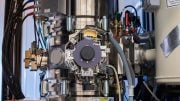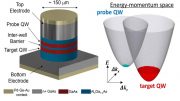
David Storm, a research physicist, and Tyler Growden, a National Research Council postdoctoral researcher, at the U.S. Naval Research Laboratory with their molecular beam epitaxy system that develops gallium nitride-based (GaN) semiconductors in Washington, D.C., March 10, 2020. Storm and Growden published their research on GaN semiconductor materials, which showed high yield and performance well suited for high frequency and high power electronic devices in Applied Physics Letters. U.S. Credit: Navy photo by Jonathan Steffen
David Storm, a research physicist, and Tyler Growden, an electrical engineer, both with the U.S. Naval Research Laboratory, developed a new gallium nitride-based electrical component called a resonant tunneling diode (RTD) with performance beyond the anticipated speed of 5G.
The fifth-generation network technology is now just starting to roll out across the United States.
Storm and Growden’s electronic component diode research findings were published on March 19, 2020, in the academic journal Applied Physics Letters.
“Our work showed that gallium nitride-based RTDs are not inherently slow, as others suggested,” Growden said. “They compare well in both frequency and output power to RTDs of different materials.”

A simplified view of the gallium nitride-based resonant tunneling diode developed at the U.S. Naval Research Laboratory’s Electronic Science and Technology Division and its performance characteristics. NRL researchers anticipate this RTD will enable technologies beyond 5G and created a process to deliver manufacturing yield of approximately 90%. Credit: NRL graphic by Tyler Growden.
The diodes enable extremely fast transport of electrons to take advantage of a phenomenon called quantum tunneling. In this tunneling, electrons create current by moving through physical barriers, taking advantage of their ability to behave as both particles and waves.
Storm and Growden’s design for gallium nitride-based diodes displayed record current outputs and switching speeds, enabling applications requiring electromagnetics in the millimeter-wave region and frequencies in terahertz. Such applications could include communications, networking, and sensing.
The team developed a repeatable process to increase the diodes yield to approximately 90%; previous typical yields range around 20%.
Storm said accomplishing a high yield of operational tunneling devices can be difficult because they require sharp interfaces at the atomic level and are very sensitive to many sources of scattering and leakage.
Sample preparation, uniform growth, and a controlled fabrication process at every step were the key elements to the diodes satisfactory results on a chip.
“Until now, gallium nitride was difficult to work with from a manufacturing perspective,” Storm said. “I hate to say it, but our high yield was as simple as falling off a log, and a lot of it was due to our design.”
Storm and Growden said they are committed to continue refining their RTD design to improve the current output without losing power potential. They performed their work along with colleagues at Ohio State University, Wright State University, as well as industry partners.
Reference: “Superior growth, yield, repeatability, and switching performance in GaN-based resonant tunneling diodes” by Tyler A. Growden, David F. Storm, Evan M. Cornuelle, Elliott R. Brown, Weidong Zhang, Brian P. Downey, Jason A Roussos, Nicholas Cronk, Laura B. Ruppalt, James G. Champlain, Paul R. Berger and David J. Meyer, 19 March 2020, Applied Physics Letters.
DOI: 10.1063/1.5139219







Be the first to comment on "U.S. Navy Researchers Create Electronic Diodes Beyond 5G Performance"